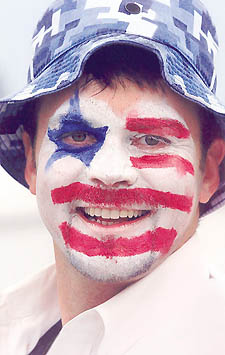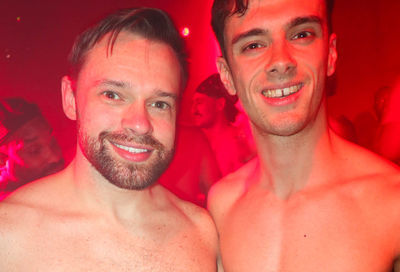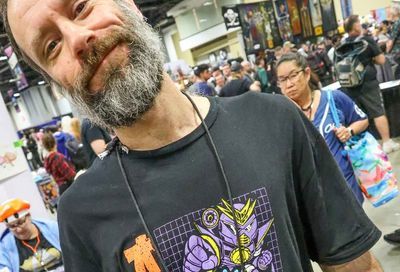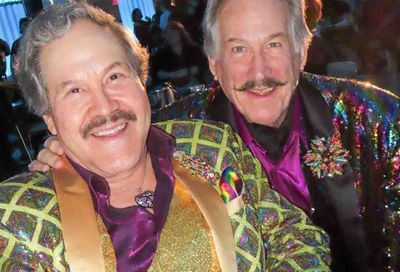Horsing Around
Gay Rodeo Clowns take on the Atlantic Stampede
When a one-ton bucking bull is tossing you around a rodeo arena like a rag doll, who’s the clown you want watching your back?
Ronald or Bozo? Sideshow or Krusty?
Yeah, right. What you need is a rodeo clown, and fast.
They may not have the big shiny pants or the preposterously large feet or even the red ball nose, but the rodeo clowns have a style all their own. They’re the ones who pull thrown riders out of harm’s way. They’re the ones who make sure that 2,000 pounds of beef runs this way, not that. And they’re the ones that keep the crowds laughing and cheering throughout the day.
 |
That’s the goal for Douglas Graff, one of the two clowns who will be gracing the arena at this weekend’s Atlantic Stampede.
“I’m a clown at heart,” he says. “There’s nothing like a spotlight on me or a microphone in my hand.”
A former Wisconsin farm boy who as an adult joined the dot-com migration to Silicon Valley, Graff is the former Mr. International Gay Rodeo 1999, and a regular fixture on the gay rodeo circuit where he got his start as a competitor before becoming a clown.
“After you get over 30, you don’t heal as easily,” says the 36-year-old. “I’ve broken a shoulder, torn a rotator cuff, and gotten a screw in my elbow. At some point you think, maybe I should back off a little bit with competing.”
Since he first filled in for a clown in L.A., Graff has found his new niche in gay rodeos across the country, helping both with the entertaining and the safety of the competitors.
“I’ve been a competitor and I know how important the clown is to the riders,” he says. “I’ve been a rodeo director and I know how important it is to put on a show for the audience.”
METRO WEEKLY: Did you like being on a farm growing up?
DOUGLAS GRAFF: It was a great place to grow up. When you’re a kid there’s no better place to be than in the country, and if you like animals a farm is a wonderful place to be. But then you get older and discover there’s a bigger world out there, and you realize just how hard it is to make money being a farmer. That was probably the biggest thing that made me decide farming wasn’t really for me — I realized that it was a lot easier to make money Monday through Friday than Sunday through Sunday in rainstorms and hailstorms and all that weather crap. I decided that it was right for me to move to the city, so to speak.
MW: How did you first get involved with gay rodeo?
GRAFF: I was out here in California on a work assignment and I met this cute cowboy. He said there was a rodeo coming up in L.A., and I should come down for it. So I went to what turned out to be the tenth annual L.A. rodeo, which was the largest gay rodeo in the International Gay Rodeo Association’s history. I was still pretty much a Midwestern farm kid, and I saw country folk being gay in this large setting with all this excitement, and raising money for AIDS charities. I had to be a part of it. I went back [home] to Michigan and I happened to discover that it was the very year that the Michigan Gay Rodeo Association was just getting started. I was involved with those first two rodeos there before I moved to California.
MW: Back on the farm, did you ever participate in a rodeo?
GRAFF: No, but I did have a horse that I took to the county fair when I was in high school. That was about it.
MW: How old you were you when you first got thrown from a horse?
GRAFF: Hell, probably four years old. My sister and I would go out and just jump on them and ride. We were farm kids, we had no fear — you bounce when you’re that age. As an adult, I respect horses a great deal. I do some pleasure riding, but I don’t compete on horses. I’ve broken so many bones now that I’ve developed more caution around horses. Going full-out running now is not something that I really look forward to doing on horses.
MW: You said earlier that after all your broken bones and injuries, you were looking for ways to stay involved without putting your body at the same level of risk. When was the first time you thought “I want to be a clown”?
GRAFF: When I was Mr. IGRA, [a California chapter] called me a couple of weeks before their rodeo because their clown had backed out on them unexpectedly. They said they knew I hadn’t done this before, but they thought I’d be good at it. And it was a blast. That’s when I decided that, since I was getting older and it made sense for me to move on to doing something else, being a rodeo clown was something IGRA needed.
MW: What exactly does a rodeo clown do?
GRAFF: If you go to a rodeo you’re going to see two types of clowns. For the bullfighter [clown], his number one responsibility is the safety of the rider. He’s there in case a rider comes out of the chute and gets in trouble — the bullfighter gets the rider out as quickly as he can, and also distracts the animal away from the rider. Whereas my duties [as the second type] are for the show. If somebody goes down and gets hurt, it’s my job to get the audience’s attention back to having fun. People come to have fun, to be out in the country and enjoy themselves. It’s my job to make sure that they do.
MW: Do you have a routine that you do while in the arena, or is what you do improvised?
GRAFF: It’s very spontaneous. At some rodeos, if they’re humming along fast they don’t necessarily need filler. But I have a pocket full of jokes that I carry with me and I’ve got some long stories that I tell if I need to. We have one skit in our back pocket for the Atlantic Stampede if we have time. It really depends on how much time we need.
MW: How do you pull together a clown outfit? Do you have any guiding principles as to what a rodeo clown should look like?
GRAFF: Number one is safety — it’s got to be something I can move quickly in. A lot of it I’ve picked up over the years. Somebody gives you something, or you see something and you just pick it up. My make-up has changed a great deal [over time], and my hair because I use my own hair now. I used to wear goofy clown wigs, but now I pretty much just wear the old hat and concentrate a more on my make-up. There’s a big difference between a circus clown and a rodeo clown. The circus clown has big, draping clothing with big shoes. That’s just not safe for a rodeo clown — we’ve got to be able to jump up, get out of the way and help the bullfighter.
MW: Rodeo clowns seem to have more of a hobo look as opposed to a circus look.
GRAFF: I haven’t studied a lot about clowns, but everybody has their own unique look. It’s about going out and being fun. When [I clowned] at the San Diego rodeo in September 2001, ten days after September 11, that was about, “We’re here, dammit, and we’re not going to crawl away and hide.” It was about not only going out and being gay, it was about being American and being proud. That was the hardest rodeo I’ve ever clowned at. They knew they had to be there, they wanted to be there, but they felt guilty for having fun with me. It was really tough to get the crowd motivated, but we did it. We did it through patriotism. I had on my red, white and blue flag shorts, and I did my face in red, white and blue with a star, all very patriotic. That really helped and gave them something to be engaged with.
The thing I look out for most of all is to get the audience connected with what’s going on in the arena. The announcer’s job is to get out the facts. My job is to connect what’s going on in the arena with the people in the crowd, so they know why something just happened, or to get them to know a contestant a little better. I know almost all the contestants on the circuit, being involved for so long, so I’ll tell a little story about them to the audience. Sometimes that gets me in a little trouble with a contestant, but they all know that it’s there for the show. If the audience is connected to the show, then they’ll come back. And it’s all about getting them to come back and enjoy what we do so we can continue to do it.
MW: How different is gay rodeo from mainstream or non-gay rodeo?
GRAFF: There are a couple of different categories of non-gay or mainstream rodeo. You have professional rodeo, which are the people making massive money doing rodeo, and then there are the many amateur rodeo circuits out there. IGRA is a pro-am circuit dominated by gay contestants — we have several straight contestants as well, and that’s great. The major differences between gay and non-gay are that in gay rodeo our women do everything that men do. We have women bull riders, women bronc riders. Our men do everything that the women do, so we have men that run barrels. If you go to a pro rodeo, women would never ride bulls or broncs and men would never run barrels. We also have our starter events, what we call our camp events. Pro rodeo doesn’t have any starter events, because they’re professionals. It’s like the difference between the San Francisco Giants and your neighborhood softball team, to some degree. It’s hard to compare us to them. But the major difference is that women do events you wouldn’t see them in the pro rodeo or many of the amateur rodeos.
MW: Are there any similarities between gay and non-gay rodeos that stand out for you?
GRAFF: The animals. We ride the same kinds of animals that non-gay riders ride. Bulls don’t know the difference. They buck just as hard with a gay rider on them as they would with a straight rider, and whether it be a man or a woman.
MW: Are gay rodeos making gay and lesbians a bigger and more accepted part of the country and western scene?
GRAFF: Well, I can’t help but think that familiarity is always a good thing. For example, we rent our stock from people who provide stock not only to gay rodeos but to other amateur and sometimes even pro rodeo. So when they come and see how we run our rodeos and get familiar with us they understand that we’re just people too. Speaking from my own experience, this year we moved our rodeo to a coastal area of California that some might call a very redneck area. It was at a working ranch with a rodeo arena that we rented. By the end of the weekend the ranch staff knew we were just folks out there having fun. I can’t help but think that because we went into that area of the country and did what we did, many people were exposed to openly gay people for the first time. Now they have a different understanding of who we are and what we do — we’re really just people.
Douglas Graff will appear at ASGRA’s Atlantic Stampede 2003 this Saturday and Sunday, Sept. 6 and 7. For a complete listing of events, see page 35.
Support Metro Weekly’s Journalism
These are challenging times for news organizations. And yet it’s crucial we stay active and provide vital resources and information to both our local readers and the world. So won’t you please take a moment and consider supporting Metro Weekly with a membership? For as little as $5 a month, you can help ensure Metro Weekly magazine and MetroWeekly.com remain free, viable resources as we provide the best, most diverse, culturally-resonant LGBTQ coverage in both the D.C. region and around the world. Memberships come with exclusive perks and discounts, your own personal digital delivery of each week’s magazine (and an archive), access to our Member's Lounge when it launches this fall, and exclusive members-only items like Metro Weekly Membership Mugs and Tote Bags! Check out all our membership levels here and please join us today!






















